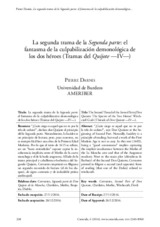La segunda trama de la Segunda parte: el fantasma de la culpabilización demonológica de los dos héroes (Tramas del Quijote —IV—)
The Second Thread of the Second Part of Don Quixote: The Spectre of the Two Heroes’ Witchcraft Guilt (Threads of Don Quixote —IV—)
Autor
Darnis, Pierre
Editor
Universidad de Córdoba, UCOPressFecha
2016Materia
Cervantes Saavedra, Miguel de, 1547-1616Segunda parte de Don Quijote de la Mancha
Clavileño
Merlín
Brujería
Diablo
Second Part of Don Quixote
Witchcraft
Devil
METS:
Mostrar el registro METSPREMIS:
Mostrar el registro PREMISMetadatos
Mostrar el registro completo del ítemResumen
“¡Cuán ciego es aquel que no ve por la
tela de cedazo!”, declara don Quijote al principio
del la Segunda parte. Naturalmente, la lucidez es
un principio de lectura; pero, para nosotros, no
es siempre fácil leer una obra de la Primera Edad
Moderna. Por lo que al texto de 1615 se refiere,
ser un “buen entendedor” supone captar la incoherencia
implícita entre el Merlín de la cueva
manchega y el de la burla aragonesa. Al lado de la
trama principal y caballeresco-berberisca del Segundo
Quijote, Cervantes imprimió en filigrana
un segundo recorrido de lectura (el de los duques),
de signo contrario y de indudable pátina
antibrujeril. “¡Cuán ciego es aquel que no ve por
la tela de cedazo!”, says Don Quixote at the beginning
of Second Part. Naturally, lucidity is a
principle of reading; but read a work of the First
Modern Age is not so easy. In this text (1605),
being a “good connoisseur” implies capturing
the implicit incoherence between the Merlin of
the La Mancha cave and that of the Aragonese
mockery. Next to the main plot (chivalrous &
Barbary) of the Second Don Quixote, Cervantes
printed in filigree a second (and opposite) form
of reading (that one of the Dukes) related to
witchcraft.

